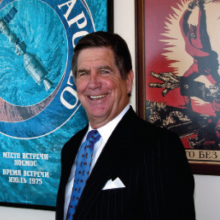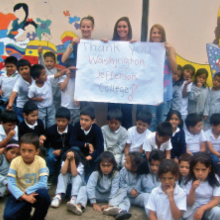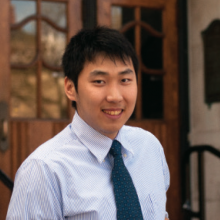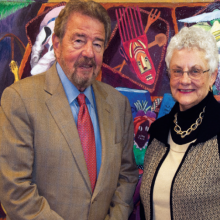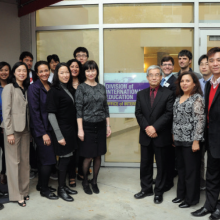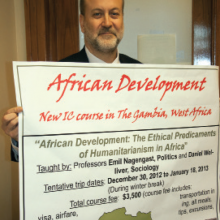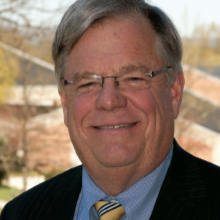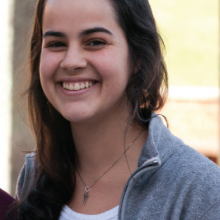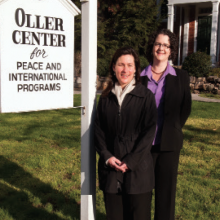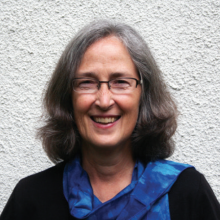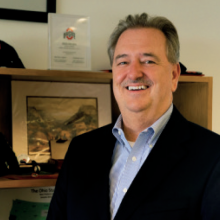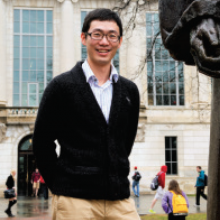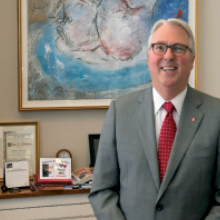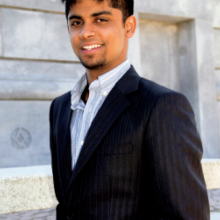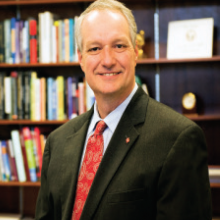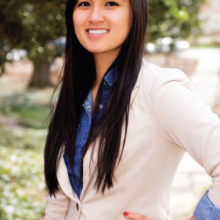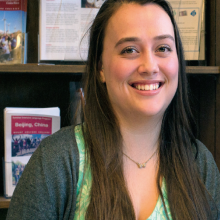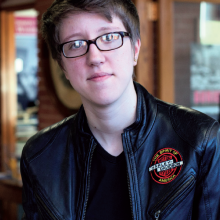2011 Comprehensive Kennesaw State
Kennesaw State University’s transformation from junior college to Georgia’s third largest university took only a few decades. It is still growing, adding its first doctoral degrees and building dorms so more than just 4,000 of its 22,000 students can live on the metropolitan Atlanta campus. With help from legendary University of Georgia coach Vince Dooley, it is preparing to field its first football team in 2014. But its academic ambitions are even grander and—as suggested by the 22-foot-high sculpture by Eino, Spaceship Earth, in the heart of campus—more global. “That’s Kennesaw State straddling the globe,” Ikechkwu Ukeje, a Nigerian-born professor and chair of elementary and early childhood education, said in jest.
But that artwork and a nearby colorful, 2.7-ton slab from the Berlin Wall both remind students and faculty every day of Kennesaw State’s international ambitions and achievements. One feather in its cap recently came in the form of a midterm report from its accreditor, the Southern Association of Schools and Colleges (SASC), which requires member institutions to single out an area for self-improvement when they seek reaccreditation. KSU intrepidly asked in 2007 to be held accountable for how much and how well it bolstered its international education programs.
SASC sent Susan Buck Sutton, then associate vice chancellor of Indiana University Purdue University Indianapolis (she is now at Bryn Mawr College), to take a look. “KSU is emerging as a national leader in international education,” Sutton wrote in evaluating the institution’s Quality Enhancement Plan (QEP). “It would be difficult to find another university where such a broad range of global learning initiatives, across all dimensions of the institution, is occurring.”
“We’ve made the Quality Enhancement Plan part of our DNA,” said Barry J. Morris, vice provost for global engagement and strategic initiatives and executive director of the Institute for Global Initiatives, who deflects credit to the faculty. Morris said KSU’s international thrust benefited from strong leadership from President Daniel Papp and his cabinet, but received legitimacy “because it was chosen from the bottom up. The faculty themselves raised the flag.”
From Junior College to Comprehensive University
KSU opened in 1966 as Kennesaw Junior College, constructed on what once was farmland in Cobb County 20 miles northwest of Atlanta. It did not start offering bachelor’s and master’s degrees until the 1980s. Now it is preparing its first doctoral students. Today it has 20,000 undergraduates (average age 25) and 2,000 graduate students. Some 1,600 are international and nearly 900 students study abroad each year. Eighty-five percent live off campus or commute and half are nontraditional. KSU proudly describes itself as “a metropolitan university.” Former President Betty L. Siegel was a vigorous proponent of KSU’s international efforts during her quarter century at the helm, and KSU took part in the American Council on Education’s Global Learning for All project aimed at helping institutions expose adult, minority, and part-time students to international education. Daniel Papp, a Sovietologist and founder of the Sam Nunn School of International Affairs at Georgia Tech, picked up the international torch when he became president in 2006.
The “Year Of” Program
A signature international activity is KSU’s “Year of Program” that spotlights a particular country, region, or international theme through a host of courses, lectures, exhibits, music, theater, and other activities that extend throughout an academic year. It started with Japan in 1984–85 and now has examined nearly two dozen countries as well as the Olympic movement and slave trade across the Atlantic. The Year of Romania was marked in 2010–11 with 33 lectures, a film festival, and other events that examined the treatment of the Roma (Gypsy) minority, persecution of Jews, post-communist religion and politics, and medieval painted monasteries. Some KSU students studied in Romania, and five faculty with Romanian roots made contributions as well. The Year of Program “is a lot of fun and a lot of work,” said Daniel Paracka, director of education abroad and manager of the Year of Program.
The 2006–07 Year of Kenya resonated with Atlanta’s sizeable Kenyan immigrant community. When the Kenyan ambassador spoke, he brought consular staff to process visas for Kenyan Americans to visit their homeland, and KSU has held follow-up conferences with support from Atlanta companies that do business in Africa. “We are still reaping the positive benefits. People now call us ‘Kenya-saw,’” said Vice Provost Morris, a Russian-speaking political scientist and former international banker.
[The Global Learning Coordination Council is] “the group that more than any other drives our internationalization efforts. This is the engine that ties the entire university together.”
Kennesaw State’s Coles College of Business recently became the new home of the India China America Institute, an economic think tank on economic and geopolitical issues involving the United States and the world’s largest emerging economies. The institute will help the business school and the university to “further engage in these countries while solidifying our position as a leader in global education,” said Ken Harmon, the business dean who is serving as interim provost and vice president for academic affairs.
A New Institute for Global Initiatives
The Institute for Global Initiatives (IGI) was created under the provost’s office in 2003 to provide what history professor Akanmu G. Adebayo, the first executive director, describes as a “one stop shop” for faculty and student research and study. It replaced a smaller Office of International Programs housed in the College of Humanities and Social Sciences. Today a Global Learning Coordination Council (GLCC) of faculty, staff, and students oversees and coordinates KSU’s international activities (Professor Ukeje is a council member). The biweekly council developed a Global Engagement Certificate that students now can earn with their diplomas. Morris calls the council “the group that more than any other drives our internationalization efforts. This is the engine that ties the entire university together.”
Ed Rugg, retired vice president for academic affairs and former chief academic officer, said the transformation from junior college to university in the 1980s left “open fields for us to run in. The undergraduate curriculum hadn’t been fleshed out…. If we had better ideas for doing something, people were willing to entertain them. Nobody was saying no.” KSU was the first public institution in the state to offer an international affairs major, and its faculty have led internationalization initiatives for the entire University System of Georgia. “Our visibility and perception as an international campus was not just mythic, but real,” said Adebayo, who is editor-in-chief of KSU’s peer-reviewed, interdisciplinary Journal of Global Initiatives.
Financing Study Abroad With Student Fees
Kennesaw State provides $1 million a year in funding for the IGI and $940,000 more for other global learning activities, said Assistant Vice President for Financial Services Ashok Roy, who is also an associate professor of Asian studies. Students voted to impose an additional $14-per-semester fee on themselves to provide Global Learning Scholarships of at least $500 for everyone who studies abroad or takes part in university-sponsored service trips overseas. Students receive as much as $2,000 if they perform service and study abroad for longer periods. The fee generates $750,000 annually, said Dawyn Dumas, director of Global Engagement Programs.
“Our philosophy is that leadership is a lifestyle. Once they’ve gone on their first trip, they are hungry to go all around the world.”
KSU has dramatically increased education abroad opportunities for math and science majors. Professor of Mathematics Jun Ji, the College of Science and Mathematics representative on the GLCC, said, “Four years ago we had one (education abroad) program with 10 students. Now we have eight programs in science and math, and we got 98 students last year.” A large poster outside Ji’s office shouts in bold letters, “YOU CAN GO TO CHINA FOR $2,100.” This includes a $750 Global Learning Scholarship plus an additional $400 per student from KSU’s Confucius Institute, one of the 68 such centers in the United States and 300 worldwide that receive support from China to encourage study of Chinese language and culture.
KSU sends students on 40 different education abroad programs, mostly for two to three weeks in the summer. With Georgia Southern and Georgia State, it offers full-semester Italian culture courses in the Tuscan town of Montepulciano. KSU ranked tenth in the 2010 Open Doors report among master’s level institutions in education abroad. The School of Nursing sends students on two-week service-learning trips to Oaxaca, Mexico. Sociologist Ardith Peters leads students to Uganda in summer to work with an NGO on adaptive sports for blind children.
‘Emerging Global Scholars’
KSU has added a President’s Emerging Global Scholars program to the mix of opportunities offered through its Center for Student Leadership (CSL). Fifty high achievers took 10-day service trips to Brazil or Mexico as freshmen and went to South Africa at the end of their sophomore year for further civic engagement activities. “Our philosophy is that leadership is a lifestyle,” said CSL Director Brian Wooten. “Once they’ve gone on their first trip, they are hungry to go all around the world.”
“Next year we’re going to India,” said sophomore Gina Perleoni. Classmate Zoe HoChoy, who grew up in Kennesaw, said never “in my wildest dreams” did she expect to have multiple education abroad experiences in college. Graduate student Punit Patel, born in Mumbai, India, but raised in the United States, said that “momentum is building year after year” on KSU’s international front. Patel, former student body president, and 21 classmates took part in the Asian International Model United Nations conference in Beijing, China, over spring break. All received Global Learning Scholarships to attend.
“One great thing about KSU is that international students are encouraged to become campus leaders,” said Dhanashree Thorat, 22, an English major from India. The university helped pay her way to give a paper at Oxford in England.
Moby-Dick in Morocco, Children’s Books in Benin
During the Year of Kenya, Karen Robinson, associate professor of theatre and performance studies, and lecturer Margaret Baldwin collected oral histories from Atlanta’s Kenyan community and mounted a play around them. Robinson, who visited Kenya with other faculty, later brought the Shangilia Youth Choir, a troupe of children rescued from the streets of Nairobi, to perform at KSU. Ten theater majors staged Melville’s Moby Dick at a collegiate festival in Casablanca, Morocco, in 2009, speaking their lines in English with selective narration in French and Arabic by students fluent in those languages.
While a graduate student, Assistant Professor of French Lucie Viakinnou-Brinson created a nonprofit called Seeds of Knowledge to provide textbooks for schools in her native Benin. Now she has students in her French classes, from beginners to advanced, write children’s books in French to donate to schools in Benin, and hopes to take students on her next trip there.
Recognition for Faculty, Student Global Engagement
Dawyn Dumas, the IGI’s director of Global Engagement Programs, spearheaded efforts to create a registry of KSU faculty and staff with international expertise. Scores of faculty have stepped forward to present credentials entitling them to be designated international education “specialists” or “contributors.” Dumas is also the point person for students seeking to earn the Global Engagement Certificate. They must have spent at least four weeks on education abroad, completed 12 credits in upper division global learning courses, and submitted a portfolio documenting service or activism on such issues as hunger or human rights. More than 100 students have earned the certificate since 2008.
Donald L. Amoroso, executive director of the new International Center for Innovation in Technologies and former chair of the Department of Computer Science and Information Systems, takes students with him twice a year to study and conduct research in Japan. “My heart is in it,” said Amoroso, an expert on advanced cell phone technology. The university spent more than $1 million converting a warehouse into high-tech classrooms and computer labs for Amoroso’s innovation center.
Though on the rise, an immediate goal for the university is to lift the graduation rate, which is still under 40 percent. Papp, Morris, and faculty leaders all believe KSU’s international thrust will help the institution keep more students on that path to a diploma.



